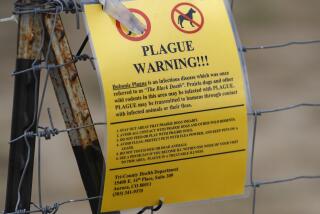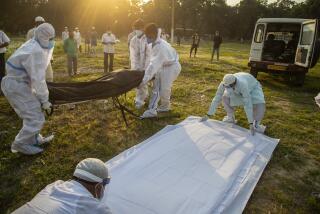India Panic Grows With Number of Plague Cases : Health: Officials say the epidemic is under control. But citizens and other nations are skeptical.
- Share via
NEW DELHI — The nurses do not dare enter Ward No. 7 at the Infectious Diseases Hospital where S.K. Tyagi is now confined. The equally fearful orderlies leave his food at the door instead of carrying it to his bed.
The 26-year-old Indian accountant, along with 107 other suspected plague victims in New Delhi, has been assigned to a hospital that is supposed to be expert in treating the dreaded disease. But he has quickly grown dubious.
“Dr. Singhal is the only person who is handling the cases,” Tyagi said Friday as he sat on his unkempt bed in the dim ward with dirty yellow walls, his mouth and nose covered with a paper mask to prevent him from transmitting the deadly bacillus by coughing or sneezing. “Nurses don’t come here; they’re scared they’ll get the plague.”
The 150-bed hospital’s harried medical superintendent, Dr. Ram Chandra Panda, used one word to describe India’s general reaction to the recent outbreaks of bubonic and pneumonic plague: “phobia.”
“It’s under control,” the doctor maintained Friday.
But across India, ordinary citizens, politicians and even medical personnel are showing by their actions that they do not believe such assurances.
Abroad, many countries have begun treating India as a public health pariah by banning travel to and from there or requiring incoming passengers from Bombay or New Delhi to submit to special health checks.
“There is some overreacting,” said Dr. Narayan K. Shah, representative of the World Health Organization in India.
On Thursday, the U.S. State Department said the risk of plague infection for international travelers is low. But at Los Angeles International Airport, federal health officers began handing out warnings to passengers arriving from India to watch for signs that they may have been exposed to the disease.
Ten days after a pneumonic plague epidemic began killing people in the industrial city of Surat in western India, the New Delhi-based National Institute of Communicable Diseases reported a total of 2,171 suspected plague cases nationwide from Surat to Calcutta, 1,000 miles away.
The government institute’s control room said there had been 45 deaths, but was apparently not aware of an 18-year-old man and a 5-year-old boy in New Delhi who the Health Ministry on Friday confirmed had succumbed to plague at the All India Institute of Medical Sciences.
Those two deaths were the farthest yet from the diamond-cutting and artificial-silk weaving center of Surat, 560 miles southwest of Delhi.
Although a vaccine and an antibiotic cure exist, few illnesses can match the plague for the atavistic reaction of fright that it produces. Though the number of suspected cases rose by more than 600 in the 24-hour period ending at 5 p.m. Friday, Shah said the progression was slow enough so he could predict that India’s first large-scale outbreak of plague in 28 years will have subsided within three or four weeks.
“There’s nothing to panic about,” Shah said. “First the number of cases will rise, and then it will go down. This epidemic will go away.”
But in New Delhi, the capital’s wary leaders ordered schools and movie theaters closed effective Friday as a way of minimizing transmission through public contact. Schools had been scheduled to close Oct. 5 anyway for Hindu religious holidays.
The New Delhi government also arranged for 500 more beds at a hospital usually used for victims of tuberculosis, and Chief Minister Madan Lal Khurana ordered the members of his Cabinet to personally supervise a crash cleanup effort.
WHO’s Shah said the emergency campaign to rid chronically filthy neighborhoods of rotting piles of garbage was not necessary on purely epidemiological grounds. The pneumonic strain of the plague, believed to have been spread by people fleeing from Surat, is transmitted by coughing, sneezing and human sputum, he said, unlike the better-known bubonic variety, which is transmitted by fleas that live on infected rats.
Of greater concern to health professionals is how the suspected plague sufferers in Delhi, 21 of whom have been proven so far to have the disease, contracted it.
More than half are not from Surat or the nearby state of Maharashtra, home to a separate epidemic of bubonic plague that broke out in early August.
To track down carriers of the bacillus, booths staffed by doctors have been set up at Delhi’s railway stations and bus terminal to look for people with coughs and fevers who are coming from Surat or Bombay, Maharashtra’s capital.
But conversations with Tyagi and his bedmates in Ward No. 7 showed how late authorities were in reacting.
Tyagi, who kept the books at a Surat iron foundry, was able to catch the train to Delhi from the plague-stricken industrial city Sunday. It was only the following day, he said, that police began to ask people streaming out of Surat where they intended to go.
Confirmed plague carrier Lala Babu Rai, who made and sold suitcases, fled Surat in a train so jammed that he and five other people had to stand for the entire trip--in the lavatory. By the time he reached Delhi, the thin, 35-year-old artisan had such a high fever and was coughing so hard that he hired a rickshaw to take him to the hospital.
Many have criticized the authorities of India and of Gujarat, the state where Surat is located, for not moving faster to stop the exodus of as many as 400,000 people. One duty officer at Delhi’s Infectious Diseases Hospital, Dr. S.K. Chadha, said some of his fellow physicians, as well as the press, also deserved criticism for their actions.
“More panic has been created than the real problem,” Chadha said. “I blame doctors, who are just scared and are sending their patients here to the IDH if they have a simple cough and fever, or even tuberculosis, rather than examining them. And in the beginning, the press gave such news: ‘Delhi is in the grip of the plague.’ But it’s not. All the stories in the papers have wreaked panic. Even the members of my family are scared.”
So, reportedly, were many Surat doctors, who fled the city. Dr. Jagdish Sobti, general secretary of the Indian Medical Assn., said many of his Indian colleagues knew little or nothing about the disease and may have been just as frightened as their patients.
“Plague is one disease not taught in medical schools,” Sobti said.
He too blamed the press, Indian and foreign, for creating panic.
“I want to say two things,” he said. “One, the plague is preventable. Two, it’s curable.”
The World Health Organization cautioned people coming to India against traveling to Surat, but said there was no need for travelers to delay visits to other parts of the country.
Other governments, including many of India’s nearest neighbors, disagreed. Sri Lanka, Bangladesh, South Korea, Nepal and Malaysia suspended air service by their national carriers. Saudia Arabia, Kuwait, Qatar, Bahrain and Oman banned all air travel to and from India.
Yemen and the United Arab Emirates closed sea links as well.
In Sri Lanka, authorities quarantined 11 cargo ships arriving from India, and 1,173 returning Tamil refugees were allowed to disembark only after their ship was held off Trincomalee for more than three hours while masked health officials inspected each returnee for possible plague symptoms.
Pakistan canceled a train running between Lahore and the Indian city of Amritsar, stranding 317 of its own nationals in India.
“The governments are not confident about the (Indian) health service,” WHO’s Shah said.
Gita R. Choksi, general manager of Thomas Cook in Bombay, said the plague scare’s impact on tourism had been disastrous. She said her travel agency had lost more than $150,000 in canceled bookings, “and the sad part is that the tourists are apprehensive about coming to India even in December.”
Gujarat Chief Minister Chhabildas Mehta told reporters Friday that there had not been a plague death reported in Surat for the last three days. A total of 12 million tetracycline capsules, an antibiotic used for both prevention and cure, have been handed out, he said.
“It is not that serious and is fully under control,” Mehta said.
The actions by leaders of neighboring Maharashtra showed that they were skeptical. On Friday, the state government empowered district magistrates to ban entry of people or vehicles from Surat and other plague-stricken areas.
More to Read
Sign up for Essential California
The most important California stories and recommendations in your inbox every morning.
You may occasionally receive promotional content from the Los Angeles Times.













